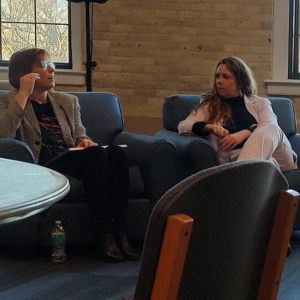Beloit Fiction Journal behind the scenes
Beloit College has a rich history of producing literary publications, from Blue Moon to Pocket Lint, but only the annual Beloit Fiction Journal features professional works of fiction submitted by writers across the country and edited by Beloit students. Through creative writing courses, students consider more than 1,000 submissions, choose the journal’s cover, design the pages, and hold a celebratory reading on campus each spring.

The Beloit Fiction Journal (BFJ) provides students with a rare opportunity: They get to edit and proof the work of professional writers for publication. BFJ editor Chris Fink, professor of English, says that every college campus is likely to have a campus journal featuring works written by students, but it would be hard to find another college with a publication featuring professional submissions edited by students.

Credit: Howard Korn’87Originally begun in 1985 by English Professor Clint McCown, the journal has always been rooted in student involvement, but the production process has shifted into the focus of a fall and spring course, which Professor Fink teaches.
The process is entirely collaborative, with students debating everything from which submissions to publish to the necessity of a comma. According to co-managing editor Alana Schacher’22, discussions over preferred stories and edits can get heated, but students learn to balance their own tastes with the personal style choices of the author.
Though the prospect of editing a literary journal is attractive primarily to creative writing majors, the fall and spring courses are open to anyone of junior or senior standing. Toryn Seeberger’22, also a co-managing editor, emphasizes that a couple of media studies majors were involved this year, along with a few STEM-related majors in the past.
“It is good to have different reading styles and interests,” Toryn says, recalling a media studies major last year who was more tuned into the logic of a story than the imagery.
In the fall, students taking the course begin by reading all the works submitted by writers of various backgrounds––a mix of professional writers, graduate students, and some individuals just beginning to test the waters of writing professionally. Around 1,100 works of fiction were submitted this year, only 15 of which will make it into the spring 2022 edition.

Credit: Howard Korn’87
Professor Fink acknowledges how daunting those numbers can seem for beginning writers. “To publish in a nationally recognized journal, the odds are against you as a writer,” he says. But he finds this to be one of the reasons student involvement in the BFJ is so important.
Not only does the experience look good on a résumé, but it exposes students to the high stakes industry of publishing and how challenging decision-making can be. “[Students are] making decisions that affect people’s livelihoods,” he says.
Both Alana and Toryn highly recommend getting involved in the BFJ. Toryn likens the process to a theater community and the experience of producing and putting on a show together. Similarly, Alana feels that even though the journal is produced through a college course, it is a lot more hands-on and involved than typical courses.
“You feel a lot of power as a student reading and editing these stories by professional writers,” Alana says. With students taking charge of every aspect of production, from proofing each story page-by-page to choosing the cover art, the BFJ is truly one of a kind. Professor Fink sees his role as an anchor for the publicity of the journal, guiding students toward putting out a professional product and only occasionally intervening to veto a decision.

Credit: Howard Korn’87
Toryn feels that their editing and revising skills have improved by participating in the BFJ, along with the ability to recognize the fundamental qualities of story structure and to identify what makes a story publishable. “I’ve discovered a lot about my own leadership style, and […] I’ve learned a lot as a writer and team member,” Toryn adds.
Stories to look forward to this spring include The Palace Motel and The Acupuncturist, two favorites of Toryn’s. As described by Toryn, The Palace Motel is a story about a little girl who lives with her found family in a motel and is told from the girl’s fairy tale-like point of view, while The Acupuncturist features slugs and everything strange. “I love a good wacky story,” Toryn says.
The Beloit community will gather to unveil the 2022 Beloit Fiction Journal at a gala reading and celebration on April 29.


